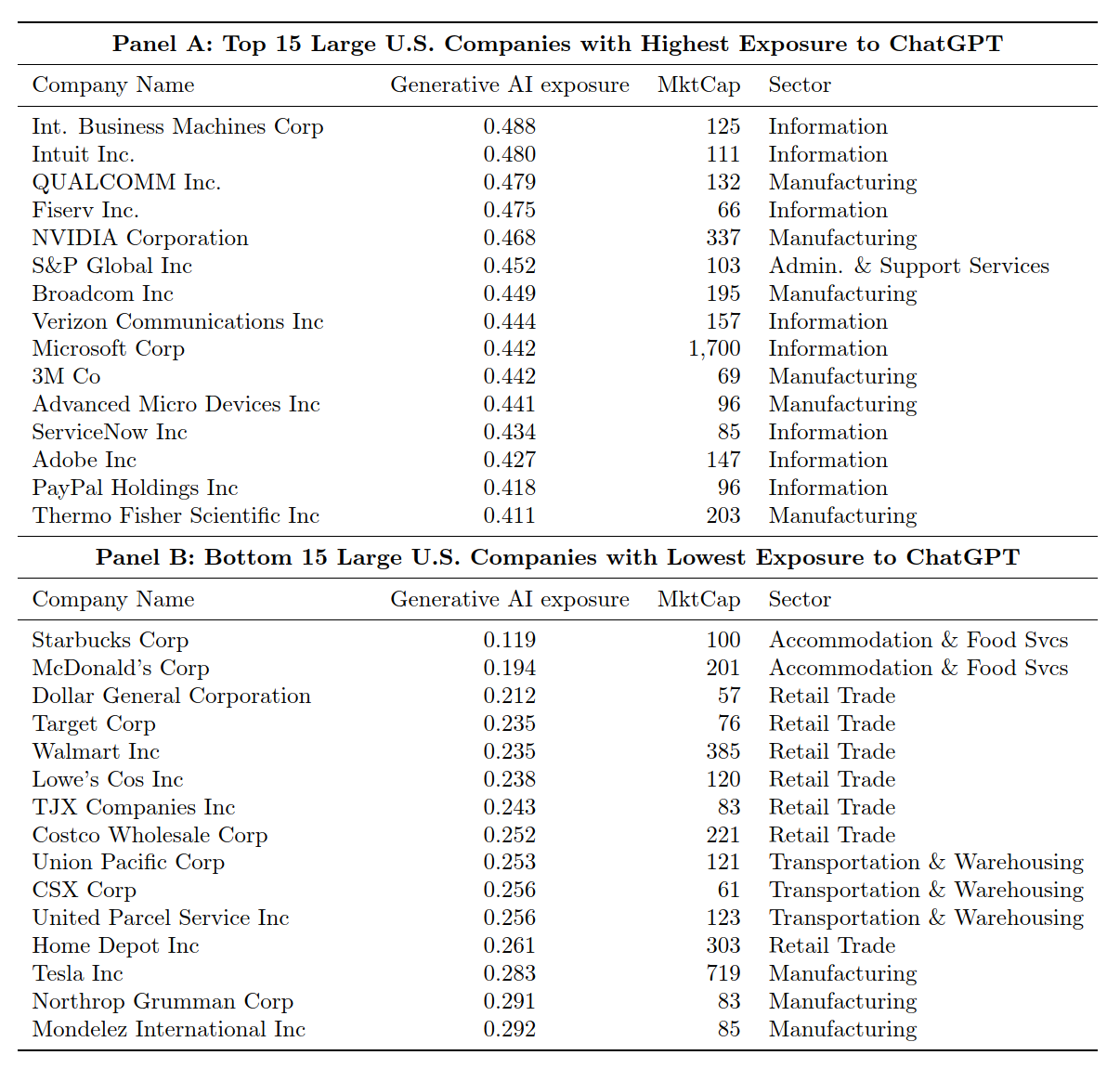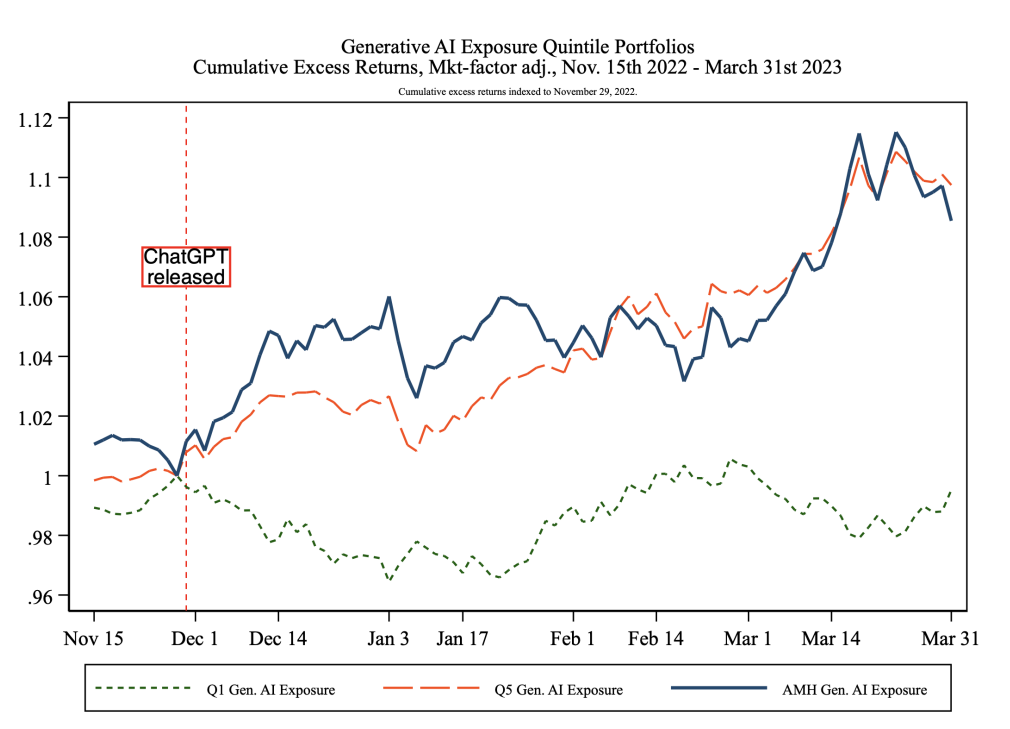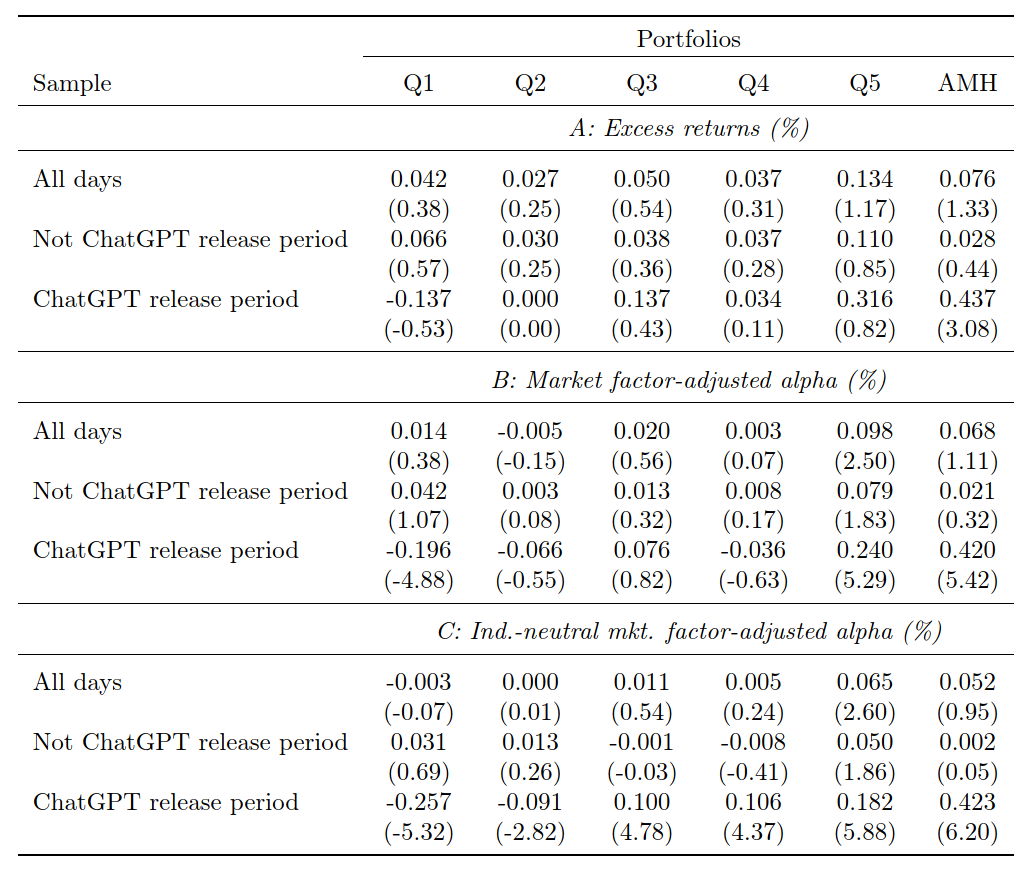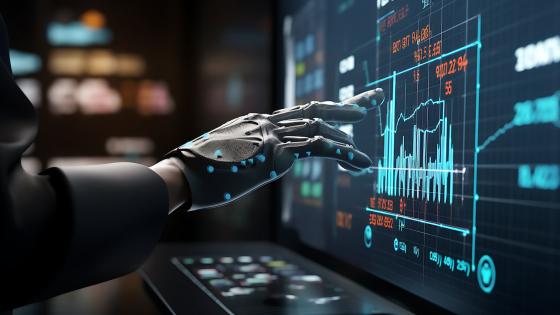Recent advancements in generative artificial intelligence (AI) have sparked significant interest due to their potential to revolutionise various industries. Compared to previous AI models, generative AI models possess the ability to process complex inputs and generate human-like outputs, making them more versatile and scalable. This has led to widespread anticipation of their adoption in the corporate sector, with potential implications for firm values.
A key question is what effect these technologies will have on corporate valuations as a result of the impact of generative AI on firms’ labour inputs. The answer can help company managers better prepare for the new technology’s impact on their firms and guide investors to allocate resources more efficiently across firms.
A major obstacle to answering this question is that measuring firms’ exposure to a new technology in real-time can be challenging. In particular, as the new technology unfolds, one would need a tremendous amount of knowledge to assess what types of labour and firms are most exposed to a new technology. Indeed, researchers typically rely on crowdsourcing such knowledge and study the impact of technologies in retrospect, when enough knowledge has accumulated.
Our approach
In a recent paper (Eisfeldt et al. 2023), we leverage the superior information-gathering and processing power of ChatGPT to evaluate whether the tasks performed by different occupations can be executed or improved by generative AI’s current or future capabilities. Merging this measure with a dataset of firms’ occupational composition provided by Revelio Labs, we capture the potential of generative AI to enhance or replace the tasks performed by labour at these firms. This two-step approach enables us to create a comprehensive firm-level measure of exposure to generative AI, which, to the best of our knowledge, is the first of its kind.
Our labour-based measure of firms’ exposure to generative AI is validated using firms’ earnings call transcripts in 2023. We observe a strong relationship between exposure to generative AI and firms’ discussions of this technology. Moreover, we find that firms with higher exposure do not merely discuss common technological topics but specifically address the impact of generative AI on their operations, including labour inputs. These results suggest that firms are recognising the broader implications of generative AI beyond its effect on products and are actively incorporating it into their strategic considerations. Table 1 lists the US firms with the top and bottom workforce exposure to generative AI. IBM, Intuit, and Nvidia rank at the top of the exposure, while Starbucks, Walmart, and UPS rank at the bottom.
Table 1
Equipped with this firm-level measure, we study the impact of the public release of ChatGPT – a major event in the advancement and dissemination of generative AI technology – on equity returns at the firm level. This event’s substantial impact on firm returns is consistent with generative AI advancement representing a major technological shock, one for which we can measure the arrival and impact in real-time. While firms may progressively adopt the technology, the unmatched media attention and user base that ChatGPT garnered within just months indicate that firms and investors are actively assessing the potential fast diffusion of this technology.
We show that Twitter mentions and earnings-call mentions of generative AI increased substantially following the release of ChatGPT. Moreover, the massive information-gathering and processing ability of ChatGPT itself allows us to assess each firm’s exposure to ChatGPT’s disruption in real-time.
Our findings
We find that the arrival of ChatGPT has a sizeable positive effect on the value of firms whose labour forces are more exposed to generative AI and related large language models (LLMs). Firms with higher exposure to the release of ChatGPT, as measured by the exposure of their labour force to becoming more productive by tools like ChatGPT, outperform firms with lower exposure by over 40 basis points in daily excess returns during the two weeks following its release. Notably, these return differences are not only due to differences in labour force exposure across industries. Returns of firms with high labour force exposure also outperform firms with low exposure by about 40 basis points daily in industry-neutral portfolios.
Firms with higher exposure to generative AI experience higher volatility around the release of ChatGPT. However, it appears that it takes some time for the information in ChatGPT’s release to be impounded into stock prices. The cumulative excess returns for the highest-exposure quintile of firms versus the lowest-exposure quintile diverge for several weeks following the release of ChatGPT. Figure 1 plots the returns of the highest-exposure quintile, the lowest-exposure quintile, and a long-short portfolio, which we denote AMH for ‘artificial minus human’. Cumulative returns to holding the AMH portfolio that is long the highest-exposure quintile, and short the lowest-exposure quintile from the released date through 31 March 2023 are over 9%.
Figure 1 Generative AI exposure quintile portfolio returns over time: Market factor-adjusted
Note: The graph shows the cumulative excess realised returns on portfolios based on value-weighted sorts. All portfolio returns shown are net of the risk-free rate. The data set consists of daily stock returns for Yahoo Finance for 15 November 2022 to 31 March 2023. The figure shows returns adjusted for market factor exposure.
We study the effect of generative AI on firm values by comparing the returns of firms with higher and lower occupational exposure to generative AI during and outside the two-week window after the release of ChatGPT on 30 November 2022. The effects are substantial, and monotonic, within industries across generative AI exposure quintiles. Adjusting for the market factor, the excess returns to quintile portfolios based on firm-level occupational exposure to generative AI are monotonically increasing. The highest-exposure quintile of firms within industries earn positive excess daily returns of over 40 basis points, while the lowest-exposure quintile experiences negative excess returns of around 25 basis points (see Table 2). The fact that these strong effects exist within many industries provides evidence that generative AI can have a broad impact on firm values through the effects on their labour inputs.
Table 2
Across industries, the effects of generative AI on firm value also vary widely. Publishing, information, and computing-related industries have positive returns following the release of ChatGPT, while finance and transportation-related industries experience negative returns overall. Dispersion in industry returns is much higher during the two weeks after the release of ChatGPT than over the full sample from 30 November 2022 to 31 March 2023.
Our findings are broadly consistent with two potential channels through which generative AI impacts firm-level free cash flows and valuations. First, firms whose labour force can be replaced with cost-effective generative AI-based capital see higher cash flows by reducing input costs. Second, firms whose labour inputs are complementary to generative AI benefit from improved technology that enhances the productivity of their workforce.
We do not take a stance on whether generative AI is a substitute for or a complement to labour. Instead, we demonstrate that firms with a higher share of occupations exposed to generative AI tend to experience value gains across industries. However, the impact of ChatGPT’s release on firm values varies significantly across industries and even within industries, indicating the potential for incumbent firms to be displaced by new entrants.
Additionally, our study identifies the types of occupations that are most affected by advances in generative AI. Figure 2 shows that non-routine cognitive tasks are found to be the most susceptible, challenging prior notions that automation primarily displaces routine tasks. Occupations involving non-routine cognitive analytical tasks or routine cognitive tasks exhibit the highest exposure to generative AI, while manual physical tasks are relatively unaffected. Interpersonal tasks lie between cognitive and manual tasks in terms of their exposure. Furthermore, higher-wage occupations demonstrate greater exposure, aligning with previous research indicating that technological advances primarily impact higher-paid workers.
Figure 2 Occupational skills and Generative AI exposure
Our contribution
Our study contributes to the literature on the impact of disruptive technologies on firm valuations. Papanikolaou (2011) and Kogan and Papanikolaou (2014) study the effects of investment-specific technological changes on asset prices. Eisfeldt and Papanikolaou (2013, 2014) examine firms’ exposure to the organisation capital technology frontier. Zhang (2019) explores firms’ exposure to routine-biased automation. In a series of papers, Babina et al. (2021, 2022) study the effects of AI on firm growth, compensation, and workforce composition. See also Webb (2019) for the impact of AI on firms. Kelly et al. (2021) study firms’ exposure to disruptive technological shocks using patent textual data, and Kogan et al. (2019) assess worker displacement from technological change over a very long sample. These studies offer important insights into investors’ and firms’ responses to technological shocks in historical samples
Our study departs from these works by focusing on measuring firms’ exposure to generative AI and assessing investors’ reaction to the technology shock. We argue that the release of ChatGPT in November 2022 is an observable, large technology shock. We also highlight our contribution of measuring investors’ reactions to this shock in real-time. Indeed, the information in market prices can potentially inform employees’ and firms’ ultimate responses to technological disruption. Timely assessment of the market’s expectations of generative AI’s impact on firms can help policymakers to effectively evaluate regulatory policies in response to the arrival of the new technology.
While other contemporaneous or recent studies such as Eloundou et al. (2023) also address the exposure of occupations to generative AI advances, our paper is novel in its contributions to the effect on firms. Our use of the Revelio Labs data to link occupations to firms yields a unique opportunity to study corporate outcomes.
References
Babina, T, A Fedyk, A He, and J Hodson (2021), “Artificial intelligence, firm growth, and product innovation”, Firm Growth, and Product Innovation (November 9, 2021).
Babina, T, A Fedyk, A X He, and J Hodson (2022), “Firm investments in artificial intelligence technologies and changes in workforce composition”, available at SSRN.
Eisfeldt, A L, and D Papanikolaou (2013), “Organization capital and the cross-section of expected returns”, Journal of Finance 68: 1365–406.
Eisfeldt, A L, and D Papanikolaou (2014), “The value and ownership of intangible capital”, American Economic Review 104: 189–94.
Eisfeldt, A L, G Schubert and M B Zhang (2023), "Generative AI and Firm Values", NBER Working Paper No. 31222.
Eloundou, T, S Manning, P Mishkin, and D Rock (2023), “GPTs are GPTs: An early look at the labor market impact potential of large language models”, arXiv preprint arXiv:2303.10130.
Kelly, B, D Papanikolaou, A Seru, and M Taddy (2021), “Measuring technological innovation over the long run”, American Economic Review: Insights 3: 303–20.
Kogan, L, and D Papanikolaou (2014), “Growth opportunities, technology shocks, and asset prices”, Journal of Finance 69: 675–718.
Kogan, L, D Papanikolaou, L Schmidt, and B Seegmiller (2019),“Technology-skill complementarity and labor displacement: Evidence from linking two centuries of patents with occupations”, available at SSRN 3585676.
Papanikolaou, D (2011), “Investment shocks and asset prices”, Journal of Political Economy 119: 639–85.
Tangalakis-Lippert, K (2023), “IBM halts hiring for 7,800 jobs that could be replaced by AI, Bloomberg reports”, Business Insider, 2 May.
Webb, M (2019), “The impact of artificial intelligence on the labor market”, SSRN 3482150.
Zhang, M B (2019), “Labor-technology substitution: Implications for asset pricing”, Journal of Finance 74: 1793–1839.










